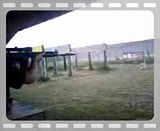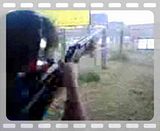Page 2 of 4
Posted: Wed Oct 31, 2007 12:37 am
by NcongruNt
age_ranger wrote:FYI, the Remington JHP from Walmart puts off quite a muzzle flash and the UltraMax ammo found at Dicks (mostly .223) has the most flash I've ever seen out of a rifle!!!
Even more than the crazy fireballs you get from Mosin-Nagant rifles? Folks have videos of them posted all over YouTube. Here's a few examples:
http://www.youtube.com/watch?v=BlRG-AfaDac
http://www.youtube.com/watch?v=70X8QiqJfAk
http://www.youtube.com/watch?v=PZ1kZSDHtJg
Posted: Wed Oct 31, 2007 3:33 am
by KBCraig
jimlongley wrote:Actually that's what those battlewagon guns appear to be doing, they are depressed too far to achieve much range.
Naval guns are very high velocity, with a flat trajectory.
Point of order: can anyone here define the difference between low-angle and high-angle fire?

Posted: Wed Oct 31, 2007 10:14 am
by jimlongley
KBCraig wrote:Naval guns are very high velocity, with a flat trajectory.
Not those guns. A 16/50 Mark 7 naval gun, which the Iowa class ships carry, has a muzzle velocity of just under 2700 fps, which could hardly be considered "very high velocity" and had a looping trajectory best described as resembling a short fly ball in baseball.
The AP (capped) 2700 pound projectiles were also designed to be high angle penetrators, so for ship to ship combat elevation angles would normally be high.
The Mark 2 turret, mounting three guns, has a lower limitation to depressing the guns based on the loading mechanism. All of the guns pictured appear to be at that elevation, leading to the assumption that a salute was being fired rather than any combat readiness exercise.
On the other hand, if those Phalanx CIWS Gatlings above the bridge were firing, then the very high velocity, flat trajectory, definitiion would fit, and it would make a pretty impressive mussle blast pic.
Posted: Wed Oct 31, 2007 2:04 pm
by KBCraig
Thanks for the clarification, Jim.
Posted: Wed Oct 31, 2007 10:01 pm
by jimlongley
This old Navy gunner is glad to help whenever he can.
Here is one of a friend shooting IDPA at night.

Posted: Wed Oct 31, 2007 11:03 pm
by KBCraig
jimlongley wrote:This old Navy gunner is glad to help whenever he can.
So for grins, are you going to tackle the difference between high angle and low angle fire?
Posted: Fri Nov 09, 2007 1:16 pm
by lawrnk
I have a CZ-52 I have yet to fire. I understand it has quite the muzzle blast. I'll maybe post this weekend.
Posted: Sat Nov 10, 2007 12:38 am
by KRM45
KBCraig wrote:jimlongley wrote:Actually that's what those battlewagon guns appear to be doing, they are depressed too far to achieve much range.
Naval guns are very high velocity, with a flat trajectory.
Point of order: can anyone here define the difference between low-angle and high-angle fire?

I don't know if I can give a definition, but I had the oportunity to serve in both an infantry unit and an armor unit in the Army. In the infantry I was in the mortar section, and we used both 60mm and 81mm mortars. These are clearly high angle weapons. They are also indirect fire weapons.
In the armor unit I was tank crewmember. The M1A1 has a 120mm main gun. This is a direct fie weapon, and I would say it has a low angle of fire.
Posted: Sat Nov 10, 2007 1:07 am
by age_ranger
I think the Ultramax ammo might have more flash, but I never recorded it and have since sold my AR.
Posted: Sat Nov 10, 2007 3:25 am
by KBCraig
KRM45 wrote:KBCraig wrote:jimlongley wrote:Actually that's what those battlewagon guns appear to be doing, they are depressed too far to achieve much range.
Naval guns are very high velocity, with a flat trajectory.
Point of order: can anyone here define the difference between low-angle and high-angle fire?

I don't know if I can give a definition, but I had the oportunity to serve in both an infantry unit and an armor unit in the Army. In the infantry I was in the mortar section, and we used both 60mm and 81mm mortars. These are clearly high angle weapons. They are also indirect fire weapons.
In the armor unit I was tank crewmember. The M1A1 has a 120mm main gun. This is a direct fie weapon, and I would say it has a low angle of fire.
Thanks for playing along, I was just jerking your chain.
Direct fire is sighted directly from the weapon to the target. Tanks are almost always direct fire, but they were sometimes used as indirect fire from WWI through Korea. Perhaps rarely in Vietnam, but we had so few tanks there (and so much artillery), it's unlikely.
High angle and indirect are not the same. Lots of mortars (which are always high angle) are direct fire, because the gunner sights directly on the target.
The question I posed stumped many of us at FAOBC 5-86. Since the question was even asked, it had obviously puzzled many generations of artillery officers.
Here's the official definition: High angle fire is that at which range
decreases with an increase in muzzle elevation. Low angle fire is that at which range
increases with an increase in muzzle elevation.
That's the official Fort Sill answer.

Posted: Sat Nov 10, 2007 10:11 am
by KRM45
Thanks for the info. I was going to say something about the mortars having such an array of different charges and elevations that would produce a different trajectory but still hit the same place...
Oh, and we could rarely see our taget... I did get to train some with the 60mm in trigger mode which is kind of neat

KBCraig wrote:KRM45 wrote:KBCraig wrote:jimlongley wrote:Actually that's what those battlewagon guns appear to be doing, they are depressed too far to achieve much range.
Naval guns are very high velocity, with a flat trajectory.
Point of order: can anyone here define the difference between low-angle and high-angle fire?

I don't know if I can give a definition, but I had the oportunity to serve in both an infantry unit and an armor unit in the Army. In the infantry I was in the mortar section, and we used both 60mm and 81mm mortars. These are clearly high angle weapons. They are also indirect fire weapons.
In the armor unit I was tank crewmember. The M1A1 has a 120mm main gun. This is a direct fie weapon, and I would say it has a low angle of fire.
Thanks for playing along, I was just jerking your chain.
Direct fire is sighted directly from the weapon to the target. Tanks are almost always direct fire, but they were sometimes used as indirect fire from WWI through Korea. Perhaps rarely in Vietnam, but we had so few tanks there (and so much artillery), it's unlikely.
High angle and indirect are not the same. Lots of mortars (which are always high angle) are direct fire, because the gunner sights directly on the target.
The question I posed stumped many of us at FAOBC 5-86. Since the question was even asked, it had obviously puzzled many generations of artillery officers.
Here's the official definition: High angle fire is that at which range
decreases with an increase in muzzle elevation. Low angle fire is that at which range
increases with an increase in muzzle elevation.
That's the official Fort Sill answer.

Posted: Sat Nov 10, 2007 5:21 pm
by Will938
Posted: Sat Nov 10, 2007 6:50 pm
by stevie_d_64
Will938 wrote:
...plink...
That was cute!

Posted: Sat Nov 10, 2007 6:54 pm
by stevie_d_64
Here's a neat video...
http://www.youtube.com/watch?v=nsNlmiLJGIw
Make sure your speakers are turned down a notch or two...
Being on the weatherdeck filming this might have been a neat idea at first...But after the first salvo...nahhhh...
Not that its "that" loud...It kinda moves you around a bit...

Posted: Sun Nov 11, 2007 2:01 am
by Will938
stevie_d_64 wrote:
...plink...
That was cute!

Laughing at my .308 caliber bullets of doom is not permitted

Here is my friend shooting the sawed off w/ a 3" magnum 00 buck, the camera missed about half the muzzleflash but you can see just how bad it kicks.



